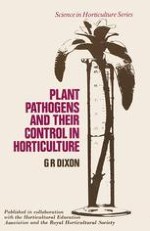1984 | OriginalPaper | Chapter
Fungi
Author : G. R. Dixon, B.Sc. (Horticulture), Ph.D.
Published in: Plant Pathogens and their Control in Horticulture
Publisher: Macmillan Education UK
Included in: Professional Book Archive
Activate our intelligent search to find suitable subject content or patents.
Select sections of text to find matching patents with Artificial Intelligence. powered by
Select sections of text to find additional relevant content using AI-assisted search. powered by
Fungi are living organisms that are devoid of chlorophyll, obtaining energy either as parasites or saprophytes. Simple organic compounds such as amino acids and monosaccharides are absorbed directly. More complex materials are degraded first by fungal-produced extracellular enzymes and then absorbed. Parasitic fungi must be capable of overcoming host resistance mechanisms in order to obtain supplies of energy. Many fungi are filamentous and multicellular although some are single cellular. Fungal nuclei are small rounded bodies, usually 2–3 µm in diameter (with some species they are up to 30 µm in diameter) and bounded by a double layer of membranes with conspicuous pores. Characteristically, the nuclear membranes persist throughout nuclear division and do not disappear at prophase as in other organisms. The nucleolus is also retained during division in some fungi. Typically, a vegetative fungal thallus (a tissue of cells that has little or no differentiation) is formed of filaments which branch in all directions. Each filament is known as a hypha and an aggregation of hyphae is known as a mycelium. Hyphae are thin transparent tubes containing protoplasm and bounded by a rigid cell wall. The walls of fungal hyphae are composed of many layers (multilaminate) each consisting of variously orientated fibrils. Characteristically, fungal cell walls contain chitin.
